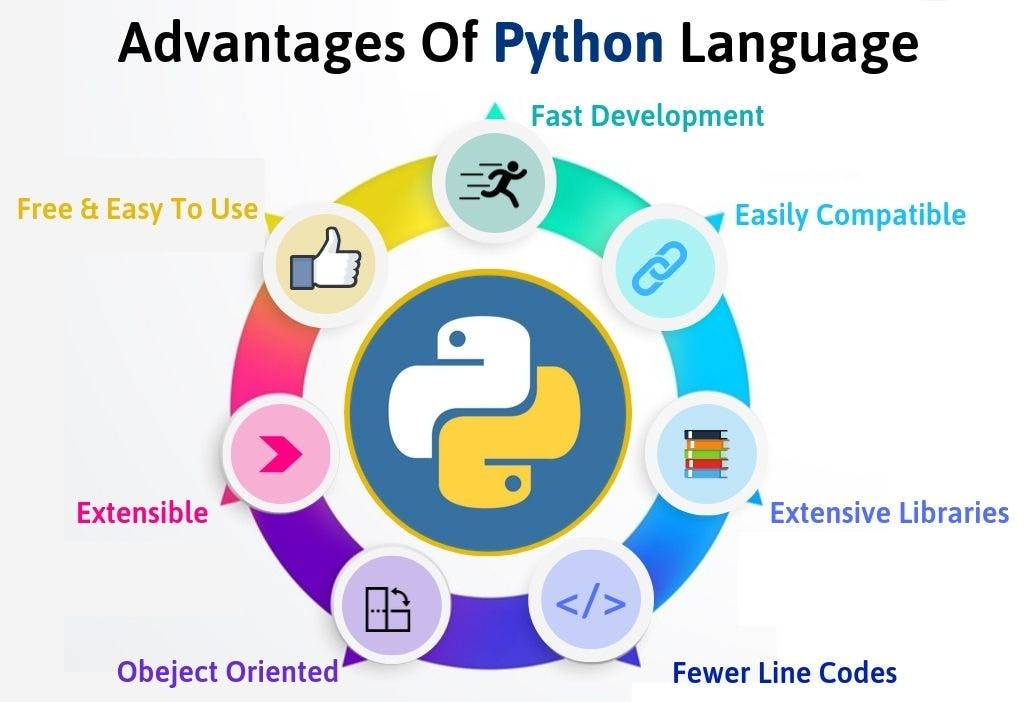What is Python [Programming Language]?
Web development, data analysis, artificial intelligence, and scientific computing all make extensive use of Python, a potent, high-level programming language. Guido van Rossum originally made it available in 1991, and since then it has grown to be one of the most widely used programming languages worldwide.
Python's readability is one of its main benefits. The language is designed to be simple to understand and write, making it a fantastic option for both novice and seasoned programmers. Python's syntax is straightforward and understandable, allowing developers to concentrate on finding solutions rather than fretting about the nuances of the language.
Advantages of using Python
Python is recognized for having a straightforward and understandable syntax, which makes it simple to learn and use for newcomers. People who are new to programming will find the language to be a fantastic choice because it is intended to be simple to understand and write.
Python is a flexible language that may be used for a variety of tasks, including data analysis, machine learning, and web development. Python is made even more potent by the abundance of third-party libraries that are available for it, like TensorFlow for machine learning and NumPy and pandas for data analysis.
Large and Active Community: Python has a sizable and active developer community, which means there is a tonne of learning and usage materials accessible. This consists of several lessons, reference materials, and discussion boards where you may ask questions and obtain assistance.
Python is a cross-platform language, which enables it to function on a variety of operating systems, including Windows, Linux, and Mac. Because of this, code may be easily written and executed on several systems without requiring any modifications.
Open-Source: Python is a language that is available for free usage and distribution. This opens it up to everyone and makes it possible for a large number of people to contribute to the language and its libraries.
Python is a high-level language, which means that it is more similar to human language than machine language. As a result, it is simpler to comprehend, develop, and interact with other programs and systems.
Large Standard Library: The Python language features a sizable standard library that contains modules for a variety of activities, such as establishing connections to web services, reading and writing files, and handling data. Eliminating the need for additional coding makes it simple to complete typical activities.
Variables do not need to be specified with a specific data type because Python is a dynamically typed language. This increases flexibility and makes it simpler to create and test programs.
Python is capable of supporting object-oriented programming, a well-liked programming paradigm. This facilitates the ability to inherit from and override methods, as well as the creation of reusable and modular code.
Python is excellent for quick prototyping because of its simple syntax and sizable standard library. This allows for quicker creation and iteration by making it simple to immediately test out new ideas.

What is Python capable of doing in real-world scenarios?
Web Development: Python can be used for web development using frameworks such as Django and Flask. These frameworks provide a set of tools for building web applications, including routing, template rendering, and database management. It also provides an ORM(Object-Relational-Mapping) layer to handle the database operations and make it easy to switch between different databases.
Data Analysis and Visualization: Python is widely used for data analysis and visualization, thanks to its powerful libraries such as NumPy, pandas, and matplotlib. NumPy is a library for the Python programming language, that adds support for large, multi-dimensional arrays and matrices, along with a large collection of high-level mathematical functions to operate on these arrays. pandas is an open-source data analysis and manipulation tool, that provides data structures and operations to manipulate numerical tables and time series data. Matplotlib is a plotting library for the Python programming language and its numerical mathematics extension NumPy. It provides an object-oriented API for embedding plots into applications using general-purpose GUI toolkits like Tkinter, wxPython, Qt, or GTK.
Machine Learning and Artificial Intelligence: Python is a popular choice for machine learning and artificial intelligence, thanks to its powerful libraries such as TensorFlow, sci-kit-learn, and Keras. TensorFlow is an open-source software library for machine learning, sci-kit-learn is an open-source library for data mining and data analysis and Keras is a high-level neural networks API, written in Python and capable of running on top of TensorFlow, CNTK, or Theano. These libraries provide tools for building and training machine learning models, as well as deep learning frameworks.
Scientific Computing: Python is widely used for scientific computing, thanks to its powerful libraries such as NumPy, SciPy, and SymPy. NumPy is already mentioned above, SciPy is a library for scientific computing and technical computing with Python. It includes modules for optimization, integration, interpolation, eigenvalue problems, etc and SymPy is a Python library for symbolic mathematics. It aims to become a full-featured computer algebra system (CAS) while keeping the code as simple as possible to be comprehensible and easily extensible.
Game Development: Python can be used for game development using libraries such as Pygame and PyOpenGL. Pygame is a set of Python modules designed for writing games. Pygame adds functionality on top of the SDL library. PyOpenGL is the most common cross-platform Python binding to OpenGL and related APIs. These libraries provide tools for building games, including 2D and 3D graphics, audio, and input handling.
Automation: Python can be used for Automation tasks such as web scraping, data extraction, automating repetitive tasks, controlling the keyboard and mouse, and interacting with the operating system.
Image and Video Processing: Python has powerful libraries for image and video processing such as OpenCV, Pillow and scikit-image. OpenCV is a library of programming functions mainly aimed at real-time computer vision, Pillow is a python Imaging Library and scikit-image is a collection of algorithms for image processing.
Natural Language Processing: Python has powerful libraries for natural language processing such as NLTK, spaCy, and genesis. NLTK is a leading platform for building Python programs to work with human language data, spaCy is a library for advanced natural language processing and gens.

Synopsis of Python Programming
Python is a high-level, open-source programming language that is known for its simple and intuitive syntax, making it easy to learn and use. It is versatile and can be used for a wide range of tasks, including web development, data analysis, artificial intelligence, and scientific computing. Python has a large and active community that provides a wealth of resources for learning and using the language. It also has a large number of third-party libraries available to extend its capabilities. It is a cross-platform language and can run on multiple operating systems such as Windows, Linux and Mac.
